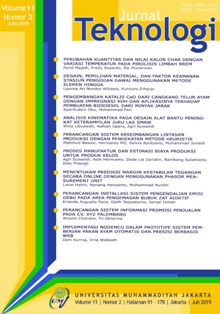PERANCANGAN INSTALLASI SISTEM PENGENDALIAN EMISI DEBU PADA AREA PENGEMASAN BUBUK ZAT ADIKTIF
Main Article Content
Abstract
Downloads
Article Details
COPYRIGHT POLICY
The author(s) of an article published in the Jurnal Teknologi retains ownership of the intellectual property rights in work (s).
PUBLISHING RIGHTS
The author(s) of an article published in the Jurnal Teknologi have unrestricted publication rights. The authors give the Jurnal Teknologi the right to publish the article and designate the Faculty of Engineering Universitas Muhammadiyah Jakarta Publishing as the original publisher of the article.
LICENSING POLICY
Journal of Mechanical Engineering and Sciences is an open-access journal that follows the Creative Commons Non-Commercial 4.0 International License (CC BY-NC 4.0), which states that:

Under this license, the reusers must give appropriate credit, provide a link to the license, and indicate if changes were made. Users may do so in any reasonable manner, but not in any way that suggests the licensor endorses users or their use.
Please take the time to read the whole license agreement (https://creativecommons.org/licenses/by-nc/4.0/). As long as reusers follow the license conditions, the owner cannot withdraw these freedoms. The following components are included under this license:
 Attribution: Users must provide appropriate attribution, including a link to the license, and indicate whether or not they made any modifications. Users are free to do so reasonably, but not in a manner that indicates the licensee approves of their usage.
Attribution: Users must provide appropriate attribution, including a link to the license, and indicate whether or not they made any modifications. Users are free to do so reasonably, but not in a manner that indicates the licensee approves of their usage.
 NonCommercial: Users may not use the material for commercial purposes.
NonCommercial: Users may not use the material for commercial purposes.
References
Azreen, N., 2014. Determination of Baseline Data on Respirable Dust Concentration for Safety and Health Enhancement in Selected Small and Medium Industries in Johor. Tun Hussein Onn Malaysia.
Glock, C.H. et al., 2019. An integrated cost and worker fatigue evaluation model of a packaging process. International Journal of Production Economics, 207: 107–124.
Hao, Y. et al., 2019. What affect consumers ’ willingness to pay for green packaging? Evidence from China. Resources, Conservation & Recycling, 141:21–29.
Hardiansyah, R. & Afiuddin, A.E., 2018. Perancangan Bag Filter pada Ruang Packing Industri Tepung Terigu. In Conference Proceeding on Waste Treatment Technology: 45–50.
Indonesia, S.N. & Nasional, B.S., 2005. Nilai Ambang Batas ( NAB ) zat kimia di udara tempat kerja. , pp.1–31.
Jia, L. et al., 2017. Improvements in the decision making for Cleaner Production by data mining: Case study of vanadium extraction industry using weak acid leaching process. Journal of Cleaner Production, 143: 582–597.
Kumar, A. et al., 2015. Evaluation of Control Strategies for Industrial Air Pollution Sources Using American Meteorological Society/Environmental Protection Agency Regulatory Model with Simulated Meteorology by Weather Research and Forecasting Model. Journal of Cleaner Production, 116: 110–117.
Libyawati, W., Suwandi, A. & Agustian, H., 2017. Rancang Bangun Teknologi Modified Atmosphere Storage (MAS) dengan Kapasitas 4,77 m3. Jurnal Teknologi, 9(2): 103–116.
Rohim, J.A. & Kristanto, A., 2016. Perancangan Sistem Kerja pada Proses Pengemasan Emping Melinjo dengan Pendekatan Ergonomi. Jurnal Integrasi Sistem Industri, 3(2): 7–14.
Schaefer, D. & Cheung, W., 2018. Smart Packaging : Opportunities and Challenges. In Procedia CIRP. Stockholm: 1022–1027.
Schnelle, K., Dunn, R. & Ternes, M., 2016. Air Pollution Control Technology Handbook 2nd editio., New York: CRC Press.
Sui, Z. et al., 2016. Fine particulate matter emission and size distribution characteristics in an ultra-low emission power plant. Fuel, 185: 863–871.
Xue, F. & Sun, B., 2018. Experimental study on the comprehensive performance of the application of U-shaped corrugated pipes into reactive mufflers. Applied Acoustics, 141: 362–370.
Yang, S., Fath, B. & Chen, B., 2016. Ecological network analysis of embodied particulate matter 2 . 5 – A case study of Beijing. Applied Energy, 184:882–888.
Zhang, H.H., Nunayon, S.S. & Lai, A.C.K., 2019. Experimental study on deposition enhancement of ultrafine particles in a duct flow by riblets. Applied Thermal Engineering, 147: 886–894.

